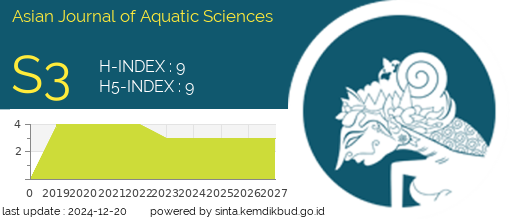The Effect of Tofu Dregs Compost and NPK Fertilizer the Growth and Production of Purple Eggplan (Solanum melongena L.)
DOI:
https://doi.org/10.31258/jnat.20.1.15-23Keywords:
Purple eggplant, Tofu waste compost, NPK fertilizerAbstract
The research was aimed to see the effect interaction of giving tofu dregs compost and npk fertilizer to get the right dose towards growth and the highest production of purple eggplant. The research was conducted at Experimental Garden, Faculty of Agriculture, Riau University, Pekanbaru. The research was conducted for 5 months, from february to june 2020. The reasearch was conducted experimentally in 2 factors. The first factor was the of tofu waste compost consists of 3 levels (0, 10 and 20 ton.ha-1). The second factor was the of NPK fertilizer (0, 100 and 150 kg.ha-1) which consist of nine treatments combination. The observed parameterswere the height of the plant (cm), the days of flowering (days), the days of harvesting (days), the fruit length (cm), the fruit diameter (cm), the number of fruits per plant (fruit), the fruit weight per fruit (g), the fruit weight per plant (g) and the fruit weight with plot (g). The data in this research was analyzed in using variance and followed by Duncan's multiple distance test at 5% level. The results showed that tofu waste compost and NPK fertilizer increased the growth of eggplant such as the height of the plant, the days of flowering, the days of harvesting, the number of fruits per plant, the fruit length, the fruit weight per fruit, the fruit weight per plant and the fruit weight with plot and does not increase fruit diameter. The giving tofu waste compost at a dose 20 ton.ha-1 and NPK fertilizer 150 kg.ha-1 gave the best eggplant growth and production until the plants were 90 DAP
Downloads
References
Ali, F., E. Muhammad, A. Karisma., 2008. Pembuatan kompos dari ampas tahu dengan activator stardec. Jurnal Teknik Kimia, 15(3): 38-45.
Asiyah, S., Y. Maryani, Darnawi. 2018. Pengaruh pemberian dosis pupuk NPK dan pupuk kotoran ayam terhadap pertumbuhan dan hasil mentimun (Cucumis sativus L.). Jurnal Pertanian, 3(1): 1-7.
Badan Pusat Statistik Riau., 2019. Riau dalam Angka. Pekanbaru.
Bagus, J., C. Wardani, I. Arsianti, D. Nasrullah., 1997. Alternatif pemanfaatan limbah buangan industri tahu dan tempe sebagai penyubur tanah. Laporan Penelitian . Universitas Brawijaya. Malang.
Cahyono, B., 2003. Teknik dan strategi budidaya terung . Pustaka Nusatama. Yogyakarta.
Hasibuan, B.E., 2012. Pupuk dan pemupukan. Fakultas Pertanian Universitas Sumatera Utara. Medan.
Harjadi, S.S., 2002. Pengantar agronomi. Gramedia. Jakarta.
Huda, F. N., Adiwirman, Nurbaiti., 2018. Pengaruh pemberian kompos ampas tahu dan pupuk NPK terhadap pertumbuhan dan produksi tanaman jagung manis. Jurnal Online Mahasiswa Faperta UR, 5(2): 1-7.
Jumin, H.B., 2002. Dasar-dasar agronomi. PT Raja Grafindo. Jakarta.
Lakitan, B., 2018. Dasar-dasar fisiologi tumbuhan. Raja Grafindo Persada. Jakarta.
Leiwakabessy, F.M., A. Sutandi., 2004. Pupuk dan pemupukan. Departemen Ilmu Tanah. Fakultas Pertanian. Institut Pertanian Bogor. Bogor.
Lingga, P., 2003. Petunjuk penggunaan pupuk. Penebar Swadaya. Jakarta.
Lestari, W,. S. Akbar., F. Sidabutar., 2016. Efektivitas penggunaan limbah padat ampas tahu sebagai pupuk organik pada pertumbuhan dan produksi tanaman bayam merah (Amaranthus Tricolor L.). Jurnal Agroplasma (Sekolah Tinggi Ilmu Pertanian) Labuhanbatu, 3(2): 12-15.
Novizan., 2005. Petunjuk pemupukan yang efektif. Agromedia Pustaka. Jakarta.
Salisbury, F.B., C.W. Ross., 1995. Fisiologi tumbuhan Jilid II. Institut Teknologi Bandung. Bandung.
Susanto, R., 2002. Penerapan pertanian organik. Penerbit Kanisius. Yogyakarta.
Winarso, S., 2005. Dasar kesehatan dan kualitas tanah. Gava Media. Yogyakarta.






